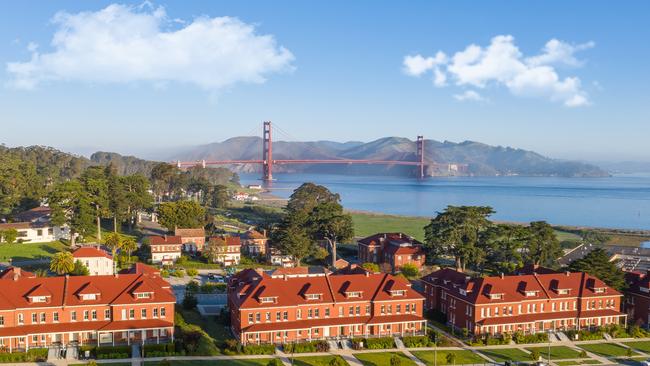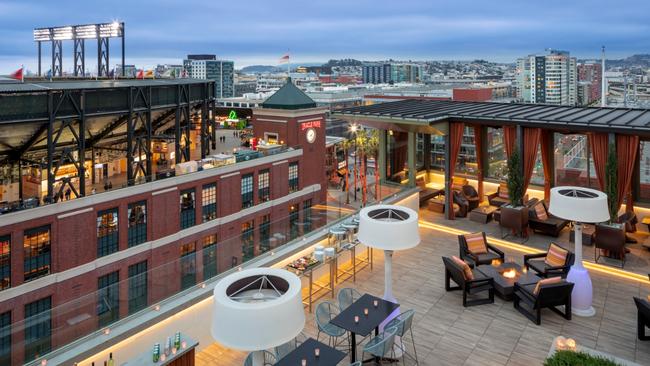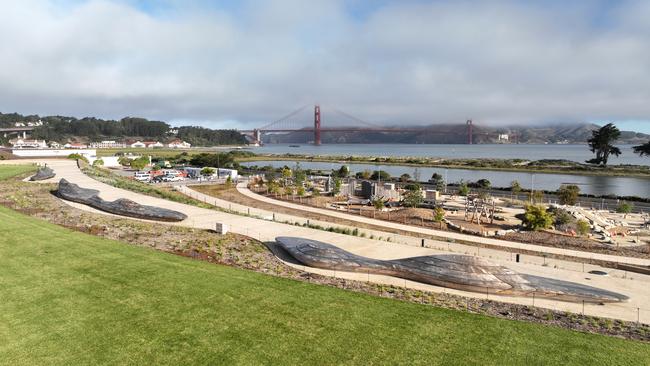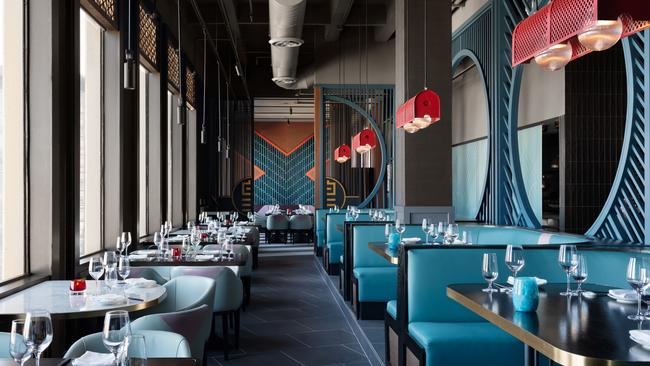Things to do in San Francisco
Presidio, a giant park that has been two years in the making, is just one of the new attractions enticing visitors to The Golden City.

It’s hard not to like a place called Dogpatch. For those who remember, it was the hootenanny setting of Al Capp’s comic strip, Li’l Abner. But it is also a waterfront neighbourhood in San Francisco that has been strengthening its reputation as a “now” centre for creatives.
Dogpatch, a one-time shipbuilding hub, is a mix of industrial buildings repurposed as artists’ studios, galleries, indie shops and cafes, and pockets of old-style San Franciscan timber dwellings, including Victorian gems that survived the 1906 quake. Jacarandas are in bloom so on a sunny morning so it’s hard to resist lazing with a coffee from Piccino, a grand yellow building that embraces a restaurant, wine, beer and nibbles shop and cafe.
Then it’s on for a locally brewed hair of the canine at the Dogpatch Saloon and I’m primed for the attractions of Third Street and environs, including art ventures galore in the Minnesota Street Project and in a mammoth converted cannery, the American Industrial Centre, which houses the Museum of Craft and Design. I ponder the purchase of customised wooden clogs (not quite me), a swing at punching bags on the pavement and body modification (careful what you wish for if you don’t fancy a forked tongue).

It’s my first visit to San Francisco since Covid and keen as I am to revisit favourites (a cable car to Fisherman’s Wharf, ferry across the bay to Sausalito, Castro Street and the height of old hippiedom, Haight-Ashbury), I also want to experience what’s new. I’ve moved from the reborn Beacon Grand hotel downtown (T+L, September 10-11) to Hotel VIA, a sleek and stylish property opposite Oracle Park, home of the San Francisco Giants and baseball heaven. It’s not a game day but I can visualise these quiet South Beach streets being transformed. Even today, fans circle the stadium, pay homage to the statues of historic greats, and swarm merchandise shops.
It’s a 30-minute stroll to Dogpatch through the remarkably transformed Mission Bay, once a no man’s land of industrial yards, now Silicon Valley in the city with impressive headquarters for the likes of Uber and a campus of the University of California San Francisco.
VIA, with 159 guestrooms and suites, is at the crossroads of sports, tech, cuisine and culture (check out the marvellous Diego Rivera’s America exhibition at the SF Museum of Modern Art, until January 2).
My guestroom is its own world in terms of size, with mini-bar at the end of an entrance hall, king-size bed of dreams and swish chaise longue angled for the street view. Neutral tones are offset by pops of aquamarine in cushions and a chair. The Rooftop, with cabanas, fire pits and bars, is a must-visit for its views.

I am heading back across the city to the Presidio, a giant park next to the Golden Gate Bridge, for a sneak preview of a project two decades in the making and to be opened within days by Speaker of the House of Representatives, Nancy Pelosi. It’s the Presidio Tunnel Tops, which adds 6ha of new parkland built above Highway 101. Gardens now connect the Main Parade Lawn of the Presidio to Crissy Field, a one-time army airstrip alongside the bay. The project, which features lush plantings, scenic lookouts, trails and picnic areas, was designed by James Corner Field Operations, the team that created New York’s High Line on a disused elevated railway track.
The Presidio, much loved by locals for its rambling open spaces, was established as a military outpost in 1776. While the original states out east were declaring Independence from Britain, the Spanish were in charge here, followed by the Mexicans and then the US from 1847 to 1994. It was the army’s main west coast base and troops left from here for World War II in the Pacific. Of the 870 buildings on the site, 470 are on the historic registry (the ANZUS Treaty was signed here in 1951) and most have been repurposed for public use.
Think of it as a place to stay with country club-like accommodation at the Lodge and the Inn, a Georgian Revival building where bachelor army officers lived. The park, now run by a trust, is reached from downtown by a free Presidio Go shuttle bus near the SalesForce Transit Centre, which has its own High Line lookalike, a rooftop urban park that weaves over four blocks, with lawns, gardens, entertainment and restaurants.
At the nearby Embarcadero I meet Rick Laubscher, a journalist and president of Market Street Railway, a preservation partner of the Municipal Railway, which operates the popular F-line streetcars and cable cars. He also runs the SF Railway Museum opposite the Ferry Building in Steuart St, which has a gem of a collection for transit enthusiasts.
A little unusually for a place that has attracted legions of immigrants, drifters and dreamers, Rick is San Franciscan by birth. He loves the city and has been an activist to preserve the best of it but doesn’t gloss over problems, including crime, an issue raised by many Australians thinking of a US trip.
There’s no denying visitors to some districts of San Francisco, such as the Tenderloin, will be confronted by sights of homelessness and drug use. Critics of the city eagerly claim it is too progressive for its own good.
Rick says San Francisco has historically been a tolerant place that gives people a second chance. It doesn’t rank high for crimes of violence, but grab-and-run theft in some neighbourhoods can go unpoliced. It’s not an issue that is going unheeded. For better or worse, a district attorney deemed too soft on crime was recently recalled by popular vote.
Oddly, back in the rip-roaring days of the 1849 gold rush, a gang of ex-convicts and ne’er-do-wells called the Sydney Ducks sought to rule the roost in North Beach, known as the Barbary Coast. They had crossed the Pacific not to dig for gold but to strike at those who did. A Vigilance Committee made short work of the Ducks, hanging four publicly. Drastic justice, perhaps.

Dine like a local
Empress by Boon, Grant Ave, Chinatown: The menu, decor (above) and view add up to dining perfection at this revamped Chinese banquet hall. A set menu with umpteen courses all light and bright, is prepared by Michelin-star chef Ho Chee Boon. Hope for dishes such as steamed shrimp and squid dumplings and grilled Alaskan black cod.
Mijote, Harrison St, Mission District: Chef Kosuke Tada arrived in San Francisco via Japan and France. His fixed-price menu is Californian-French with dishes influenced by “the seasons, weather, team’s emotions and offerings of local producers”, paired with natural wines.
Colibri Mexican Bistro, Moraga Ave, Presidio: Authentic Mexican cuisine is offered by owners Eduardo and Sylvia Rallo in the Officers Club, one of the city’s oldest buildings.
In the know
United Airlines flies from Sydney to SFO daily and from Melbourne three times a week. On October 28, thrice-weekly flights from Brisbane will be added.
Rooms at Hotel VIA from about $US249 ($370) a night. Railway Museum open Tuesday-Saturday, noon-5pm; free.
Graham Erbacher was a guest of United Airlines, San Francisco International Airport and San Francisco Travel Association.

To join the conversation, please log in. Don't have an account? Register
Join the conversation, you are commenting as Logout